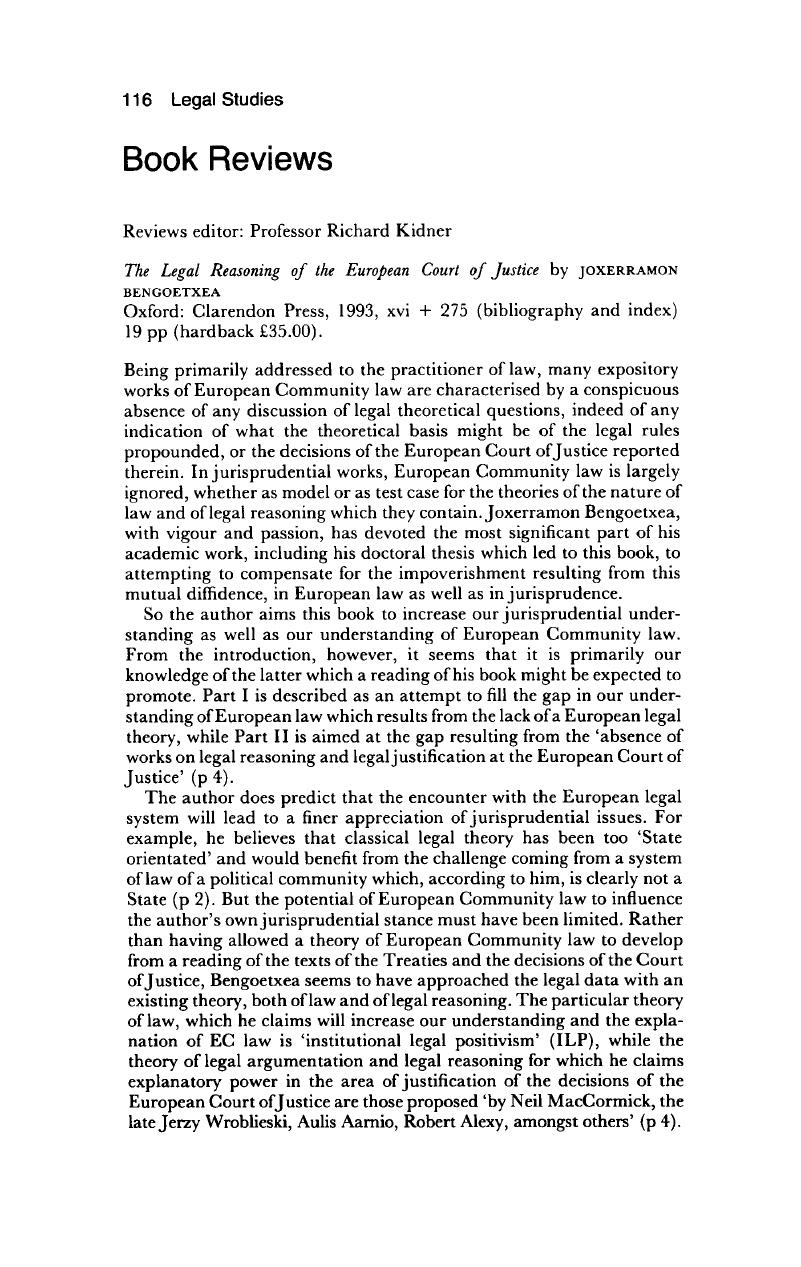No CrossRef data available.
Article contents
The Legal Reasoning of the European Court of Justice by Joxerramon. Bengoetxea Oxford: Clarendon Press, 1993, xvi + 275 (bibliography and index) 19 pp (hardback £35.00).
Published online by Cambridge University Press: 02 January 2018
Abstract

- Type
- Book Review
- Information
- Copyright
- Copyright © Society of Legal Scholars 1994
References
1. The characterisation of modern positivism as being dominated by these notions is controversial. Surely, one of the aims of Hart's version of positivism precisely was to abandon, or at least qualify them. MacCormick has shown how Hart's theory can be adapted to overcome the problems associated with classical positivism: see ‘Beyond the Sovereign State’ (1993) 56 MLR 1.
4. See eg Raz ‘On the Automony of Legal Reasoning’ (1993) 6 Ratio Juris 1.
3. Such as Alexy, MacCormick, and Aarnio; he seems to want to agree with all three, see the rather confusing statement of what I take to be his own view on pp 170–1.
4. See, in particular, p 170: ‘Still, there is a sense in which the justification of a decision in a clear case is related to morals: the underpinning decision to apply the law and to use that norm as a standard according to which to judge the acts of others is a moral-political decision.’
5. As I said, Bengoetxea's terminology is confusing. On p 160, he labels lawyers' and citizens' reasoning as justification, but then qualifies this by stating that the justification of judical action is the paradigm case of legal justification.
6. In Part I, on p 54, he in fact lists Dworkin's theory alongside Hart's and Kelsen's theories as a criterion for validity. He then encapsulates the difference between his own and Dworkin's views in the rather meek statement that, in his opinion, ‘looking into the law-records can guide the question of the validity of law to a higher degree than Dworkin seems willing to concede’ (p 56). See also in Part 11, p 146, ‘…unless, in a Dworkinian fashion, one understands by valid law, not only the propositions expressed by legal norms but also further principles of legal and political theory which are supposed to inspire and be embodied in these norms’.
7. Dworkin only introduced the distinction in order to challenge the positivist notion of validity. In his own theory, easy cases are just that, easy (at least for the moment).
8. A good recent example of this is the decision of the House of Lords in R v London Transport Authority [1992] 1 CMLR 5. In this case, Lord Templeman (delivering the only speech of the House) was confident in interpreting art 130, r (4) of the Treaty of European Union in a way which safeguarded national environmental legislation. This required Lord Templeman not only to interpret the said article of the Treaty, but also to decide on the correct balance between the pursuit of a Community environmental policy (as provided for in the article) and other Community objectives. The interpretation of art 130, r (4) involves inter alia an interpretation of the nature and scope of the ‘subsidiarity principle’; this principle entails a test for the division of power between the Community and the Member States with which, in a European judge's words, ‘much is left to discretion and which is ultimately a matter for political choice’ (Judge Kapteyn, cited by Emiliou (1992) 17 ELR 383 at 395; see also Webb v EM0 Air Cargo (CJK) [1992] 2 All ER at 43 (the decision was overruled by the House of Lords, see [1992] 4 All ER 929).
9. In Webb v EMO Air Cargo (UK), above, the Court of Appeal used what was clearly an English approach to the determination of the ratio decidendi or ‘rule’ of a decision of the ECJ, see eg Balcombe LJ at 60.


